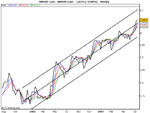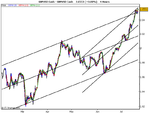Atilla
Legendary member
- Messages
- 20,972
- Likes
- 4,130
Hi everyone,
I thought I start off this weeks thread as I have wondered off cable recently. My eye is still here browsing and reading the threads. Amazed by cables run and other currencies response to the dollar slide.
Here is an interesting article from the Investors Chronicle to get the grey cells pondering. It looks at money, the Asian markets and price of commodities.
Also, on a TA level my favourite Std Err channel is showing the bull run of the cable as being still in tact and pointing to $2.1 before it eases off on the weekly charts.
On the 4 hour charts there may be some drop and if 2.05 holds and makes another upturn and breaches 2.0588 or 2.06 then $2.1 is on sight without a doubt.
I really feel uncomfortable at these levels but I strongly believe until the US imports sufficient level of inflation and decides to act on interest rates to sort out it's defecit, this will continue. This is economic warfare without doubt. A new offensive on the dollar has started and the US is waiting for the end of the elections before corrective action is taken.
Hence, I'm bullish on cable above 2.0500 if these levels can be consolidated.
The end of easy money
Created: 17 July 2007 Written by: Chris Dillow
The days of easy global money might be coming to an end.
The problem is not just the prospect of higher interest rates in the UK, the eurozone and Japan. It's also that monetary growth in Asia is slowing. The annual growth rate of the M1 money stock in Korea and Hong Kong has turned negative, and it's halved in the past few months in Indonesia.
Our measure of annual M1 growth in non-Japan Asia - a gross domestic product (GDP)-weighted index of growth in Korea, Thailand, China, Philippines, Indonesia, Singapore, Malaysia, Taiwan and Hong Kong - has slowed from 17.5 per cent in February to 12.4 per cent in May. This is just under its post-1997 average growth rate of 13 per cent.
The reason for this slowdown is not that central banks have much reduced their printing of money to support the US dollar. Latest figures (which are only for March as the People's Bank of China is slow to report) show that non-Japan Asia's foreign exchange reserves have grown at an annual rate of 24.2 per cent - the biggest rise for 18 months. Such growth often leads to faster domestic money growth, as central banks sell domestic currency to buy dollars, but don't issue sufficient Treasury bills to offset (or sterilise) the increased domestic money stock.
More likely, though, the slowdown reflects slower money demand as a result of expectations of slower economic growth in the region. Annual industrial production growth in China fell from 36.6 per cent to 26.9 per cent between January and April. And output in Japan - a major source of demand in the region - has fallen at an annualised rate of 3.1 per cent in the past six months.
Our chart shows why this matters. It shows that slowdowns in our measure of the Asian M1 money stock - for example, in 1998, 2001 and 2005 - led to falling commodity prices, while faster growth - in 1999 and 2004 - led to rising prices. This shouldn't be surprising as Asian economies, with their large manufacturing sectors, are big buyers of commodities.
This link suggests that the recent rise in commodity prices - up more than 10 per cent since January - might not continue for long.
Equally, though, there's no need to panic just yet. Monetary conditions are only less loose than a few months ago - they're not exactly tight. So the skies are still blue, it's just that a few clouds are bubbling up.
PS Forgive me for not caring about the non carers regarding directions of cable... :cheesy:
In all honesty I don't care either as I will short or go long - all depends on where I see potential profits in trading one way or another...
Good trading everyone... 🙂
I thought I start off this weeks thread as I have wondered off cable recently. My eye is still here browsing and reading the threads. Amazed by cables run and other currencies response to the dollar slide.
Here is an interesting article from the Investors Chronicle to get the grey cells pondering. It looks at money, the Asian markets and price of commodities.
Also, on a TA level my favourite Std Err channel is showing the bull run of the cable as being still in tact and pointing to $2.1 before it eases off on the weekly charts.
On the 4 hour charts there may be some drop and if 2.05 holds and makes another upturn and breaches 2.0588 or 2.06 then $2.1 is on sight without a doubt.
I really feel uncomfortable at these levels but I strongly believe until the US imports sufficient level of inflation and decides to act on interest rates to sort out it's defecit, this will continue. This is economic warfare without doubt. A new offensive on the dollar has started and the US is waiting for the end of the elections before corrective action is taken.
Hence, I'm bullish on cable above 2.0500 if these levels can be consolidated.
The end of easy money
Created: 17 July 2007 Written by: Chris Dillow
The days of easy global money might be coming to an end.
The problem is not just the prospect of higher interest rates in the UK, the eurozone and Japan. It's also that monetary growth in Asia is slowing. The annual growth rate of the M1 money stock in Korea and Hong Kong has turned negative, and it's halved in the past few months in Indonesia.
Our measure of annual M1 growth in non-Japan Asia - a gross domestic product (GDP)-weighted index of growth in Korea, Thailand, China, Philippines, Indonesia, Singapore, Malaysia, Taiwan and Hong Kong - has slowed from 17.5 per cent in February to 12.4 per cent in May. This is just under its post-1997 average growth rate of 13 per cent.
The reason for this slowdown is not that central banks have much reduced their printing of money to support the US dollar. Latest figures (which are only for March as the People's Bank of China is slow to report) show that non-Japan Asia's foreign exchange reserves have grown at an annual rate of 24.2 per cent - the biggest rise for 18 months. Such growth often leads to faster domestic money growth, as central banks sell domestic currency to buy dollars, but don't issue sufficient Treasury bills to offset (or sterilise) the increased domestic money stock.
More likely, though, the slowdown reflects slower money demand as a result of expectations of slower economic growth in the region. Annual industrial production growth in China fell from 36.6 per cent to 26.9 per cent between January and April. And output in Japan - a major source of demand in the region - has fallen at an annualised rate of 3.1 per cent in the past six months.
Our chart shows why this matters. It shows that slowdowns in our measure of the Asian M1 money stock - for example, in 1998, 2001 and 2005 - led to falling commodity prices, while faster growth - in 1999 and 2004 - led to rising prices. This shouldn't be surprising as Asian economies, with their large manufacturing sectors, are big buyers of commodities.
This link suggests that the recent rise in commodity prices - up more than 10 per cent since January - might not continue for long.
Equally, though, there's no need to panic just yet. Monetary conditions are only less loose than a few months ago - they're not exactly tight. So the skies are still blue, it's just that a few clouds are bubbling up.
PS Forgive me for not caring about the non carers regarding directions of cable... :cheesy:
In all honesty I don't care either as I will short or go long - all depends on where I see potential profits in trading one way or another...
Good trading everyone... 🙂
Attachments
Last edited:


